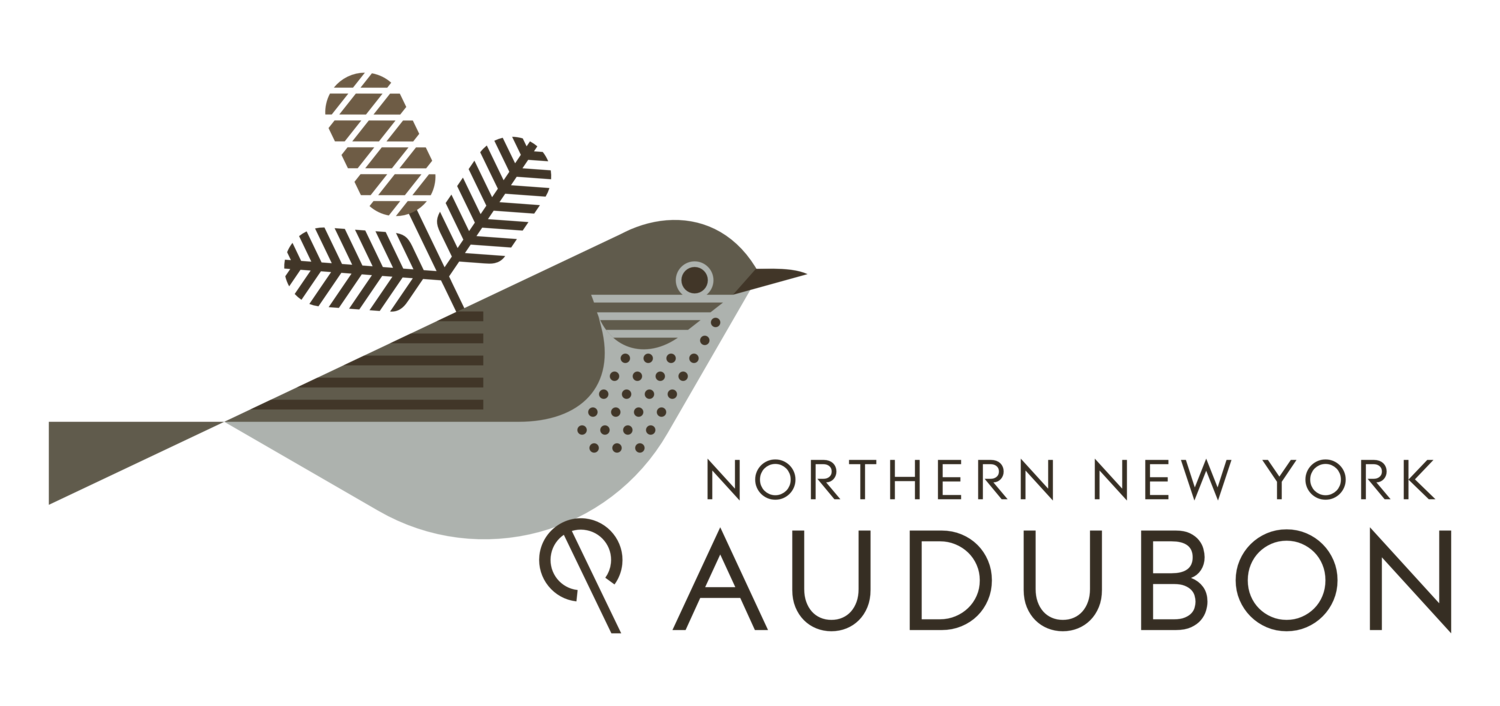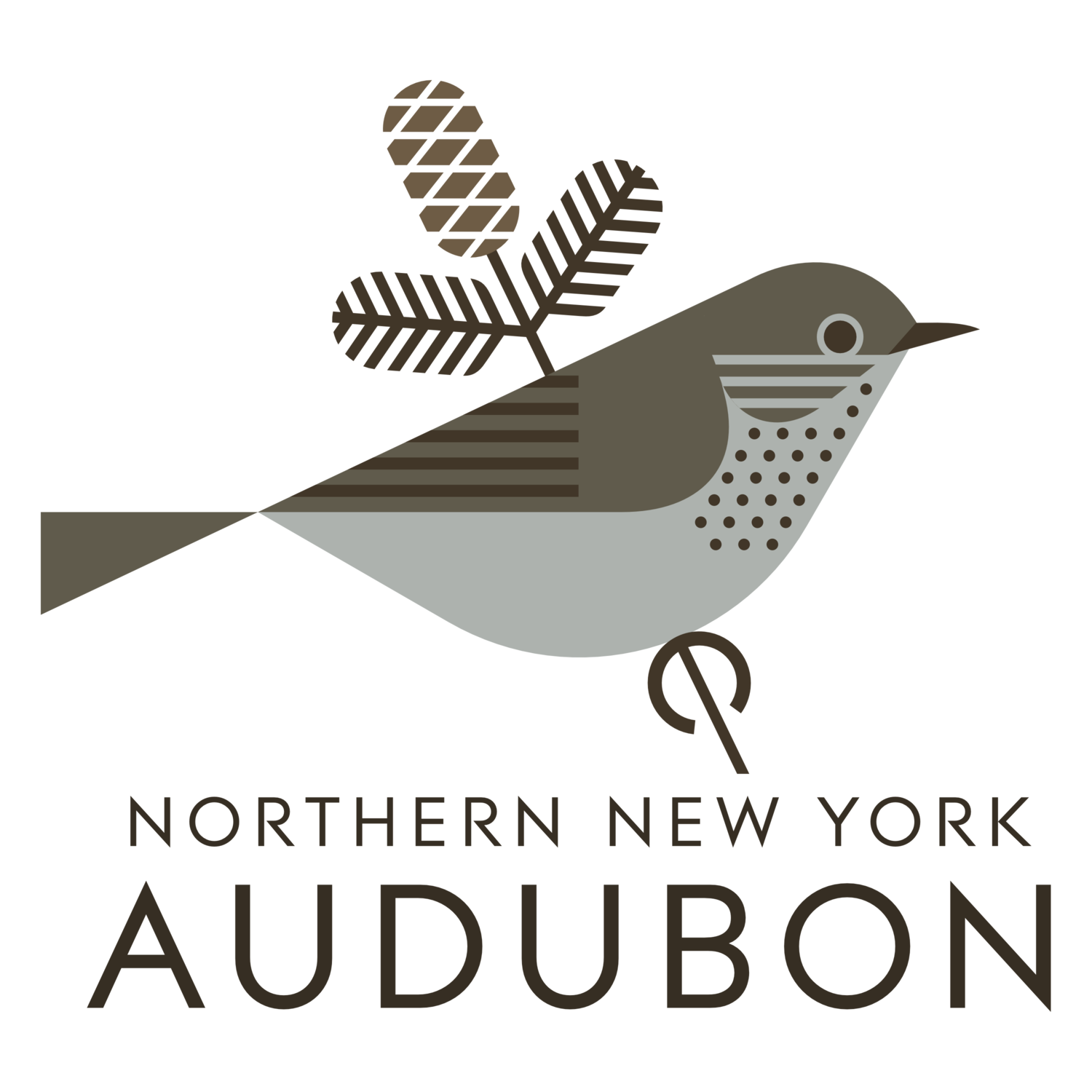
Our History
Northern New York Audubon (NNYA), a 501 (3) (c) not-for-profit corporation, began its existence as High Peaks Audubon Society, Inc., in 1978, and then, in 2008, merged with St Lawrence/Adirondack Audubon, another local chapter of National Audubon Society.
The boards of both organizations felt that a larger Audubon chapter embracing significantly more territory in northern New York, and a twofold increase in membership, would benefit both organizations as well as the memberships they served. The members at large agreed and handily exceeded the ten percent in favor votes needed to ratify the merger. Northern New York Audubon has since maintained a steady membership of approximately 859-900 members, 598 of which belong only to National Audubon Society and get assigned to Northern New York Audubon based on their zip codes (162 of these National Audubon Society members also donate annually to NNYA); in addition, 231 members are NNYA only.
High Peaks Audubon Society is Founded
High Peaks Audubon Society (HPAS), the initiative of Norman Mason, a retired Episcopalian Priest, initially had trouble gathering the thirty-five members required for a National Audubon Society chapter, but eventually achieved that threshold and then incorporated as a 501 (3)(c). For many years, John M.C. Peterson functioned as the organization’s driving force, editing its newsletter for twenty-five years and developing and overseeing its two signature initiatives—the Four Brothers Island gull banding project, and the Crown Point Bird Banding Station.
Four Brothers Gull Banding Project
Peterson, on behalf of HPAS, entered into a contract with The Nature Conservancy/Adirondack Land Trust to manage Four Brothers Islands, a group of four islands in Lake Champlain, approximately two miles offshore from Willsboro, and over the next ten years visited the islands once a year and banded a thousand gulls per annum, mostly ring-billed gulls but quite a few herring and great black-backed gulls as well. The annual banding on Four Brothers attracted many volunteers and amounted to a major educational and environmental experience for many attendees.
The Four Brothers Islands program banded 25, 352 individuals of 12 species, with some birds recovered as far afield as Terceira, the Azores, Ireland, and Spain. On one occasion, the group encountered sixteen dead double-crested cormorants arranged in a tight pattern among dozens of .22 caliber shell casings and 20 gauge shotgun shells. It made for a powerful environmental statement not lost on the young volunteers.
Crown Point Bird Banding Station
Peterson also started the Crown Point Bird Banding Station, which celebrated its fortieth consecutive year of operation in 2015. The station, from 1976-2015 has banded 18, 604 individual birds of 106 species, 28 of them warblers, and has hosted thousands of visitors, from school groups to prisoners from the Mariah Shock Incarceration facility. It represents a major environmental/educational initiative and operates entirely on a volunteer basis. It separated from HPAS in 2004, when the Crown Point Bird Banding Association formed.
Peterson’s Legacy
Peterson's tenure as HPAS newsletter lasted for twenty-five years, during which he held forth with relentless regularity on all things Adirondack, especially birds, and his efforts won accolades from NAS, which named the newsletter the Best National Audubon Society Chapter Newsletter of the Year and flew Peterson to Colorado to receive an award. Peterson also served as the Region 7—Adirondack/Champlain editor of The Kingbird, the journal of the New York State Ornithological Association for twenty-six years, keeping track of avian sightings throughout the Adirondacks and submitting detailed reports quarterly.
HPAS published two books, Birds of Essex County (edited by Peterson) by Geoffrey Carleton and Birds of Clinton County (edited by Thaxton) by Charles W. Mitchell and William E. Krueger.
Peterson also, under the aegis of High Peaks Audubon Society, served as regional coordinator for the Atlas of Breeding Birds in New York State and the Second Atlas of Breeding Birds in New York State, a monumental task he performed twice.
When Peterson retired as editor of the HPAS Newsletter, his two immediate successors failed to publish consistently, and the newsletter went unpublished for several issues. Then, during an annual dinner at the Westport Yacht Club, Joan Collins asked John Thaxton, the HPAS Publications Chair, if she could try her hand at publishing the newsletter, and Joan went to press every deadline for five years, finally announcing, after moving to Potsdam and joining SLAA that she would be editing their newsletter and giving up the editorship of the HPAS newsletter.
John Thaxton, as Publications Chair of HPAS, appointed himself newsletter editor upon Joan’s departure and continued as editor of the NNYA newsletter until 2020.
Annual Birding Celebrations Begin
In 2003, HPAS board member Brian McAllister conceived of the Great Adirondack Birding Celebration, a three-day festival featuring field trips, workshops, lectures, and other activities that HPAS organized with the staff of the Paul Smiths VIC. This birding celebration has taken place every year since and attracted visitors from all over the United States and Canada hoping to see the signature Adirondack boreal bird species, such as Bicknell’s thrush, boreal chickadee, canada jay, and black-backed woodpecker.
The Celebration’s keynote speakers have included Dr. Frank Gill, Lang Elliott, Dr. Bridgette Stutchberry, Dr. Peter Mara, Scott Weidensaul, Dr. Sara K. Morris, Noah Stryker, and Richard Crossley.
Initially free, the Celebration, owing to the budgetary needs of the Paul Smiths VIC, started charging participants in 2010, with very little impact on attendance—the field trips seemed to attract the same numbers of participants, and the auditorium still filled up for the keynote address. NNYA continues to support the celebration by offering an honorarium to the keynote speaker and leading many of the field trips.
In 2005, the Hamilton County Bureau of Tourism started the Adirondack Birding Festival, which consists of field trips, lectures and a dinner cruise, and reached out to HPAS board members for help in designing and leading the field trips. Joan Collins played an instrumental role in planning the Adirondack Birding Festival and asked John and Pat Thaxton for help in leading the field trips. Joan Collins and the Thaxtons have led field trips every year of the festival, and Joan and John have delivered lectures at several Festivals. Hamilton County designed the Festival to take place the weekend after the Great Adirondack Birding Celebration, with the result that attendees frequently spend the week in between the two in the Adirondacks.
Annual Cullman Grant Awards
In 2007, Joel Treisman of the Joseph and Joan Cullman Conservation Foundation contacted then High Peaks Audubon Society president Pat Thaxton to inform her of a grant of ten thousand dollars to be used to fund conservation and education initiatives. After an at times problematic discussion, the HPAS board decided to give away all of the Cullman grant money rather than put half of it in the bank. To date, the Cullman Foundation has given HPAS and then Northern New York Audubon ten thousand dollars ($10,000) or more per year.
Some of the initiatives HPAS/NNYA funded include: half the salary of a full-time intern at The Wild Center; a significant portion of an intern to work on the Wildlife Conservation Society’s (WCS) Boreal Bird Initiative; a significant portion of an intern to work on the Biodiversity Research Institute’s Adirondack Loon Conservation Project; a study of white-crowned sparrows on Cranberry Lake; a significant portion of the WCS study of Bicknell’s thrush and other high-elevation boreal birds; a study at Smithy Creek Bird Banding Station; nets for the Crown Point Bird Banding Station; a study of the effects of acid deposition on songbird populations;
Dr. Janet Mihuc’s Project Silkmoth; two studies of rusty blackbirds; a study of bird population trends at Spring Pond Bog; Angelina Ross’s Spruce Grouse Management Plan; bird point counts at Shingle Shanty Preserve; DNA sequencing of Bicknell’s thrush via the nucleotides of mitochondrial ND2; a study of the effects of exurban sprawl on songbirds by studying the hematocrit volume and plasma triglyceride levels of ovenbirds; the All Taxa Biodiversity Inventory; a study of golden-winged warblers at the Indian River Preserve; the Living Bird Exhibit done by the Northern Forest Institute; the WCS’s publication of The State of the Adirondack Boreal, Part 1: Composition and Geography and Part 2: Changes and Threats by Jerry Jenkins; the development of two new routes for Mountain Birdwatch.
Additional Grant Funding
In 2010, Nancy Smith Collins, who lived in Malone, and her family gave NNYA a bequest of fifty thousand dollars to use as we saw fit, and after a discussion the board decided to invest the money in the Adirondack Community Trust and to spend it down over the course of ten years, figuring that with a little luck we could award five thousand dollars in grants for eleven years. Some of the projects funded include: Bird-friendly Hayfields as Refugia for North Country Grassland Birds by Dr. Susan K. Willson; Avian Biodiversity Indicators to Diagnose the Health of Estuarine Wetlands in the Massena Great Lakes Area of Concern by Dr. Tom Langen; Red-headed Woodpecker Breeding Ecology and Nest-site Selection at the Northern Limit of its Distributional Range by Jacob L. Berl; Recurring Bird Surveys in Lowland Boreal Habitat at Shingle Shanty Preserve and Research Station by Stephen Langdon; The American Kestrel Project by Mark Manske; Initiation of a Monitoring Program for Climate Change Adaptation: Fixed Radius Bird Surveys at Intervale Lowlands by Dr. Ezra Schwartzberg, who also received a grant to construct a High School Phenology Trail at National Sports Academy, in Lake Placid.
HPAS and NNYA have managed the Rutkowski Fund, an endowment of two thousand dollars donated by David and Catherine Rutkowski in memory of their son, using the interest to partially cover the cost of sending a child to one of the NYS DEC summer camps. The fund has almost tripled in value over the past twenty years.
Since 2010, NNYA has sent either a board member or a teacher from the area to NAS’s Hog Island, an educational summer camp on an island off the coast of Bremen, Maine that offers a week-long program for Audubon leaders and another one for environmental educators. The board members and teachers who have participated in the programs have described them with lavish praise.
NNYA sends out one direct mail appeal a year, which raises approximately eight thousand dollars and more than covers the annual expenses, such as liability insurance and the cost of printing paper copies of the newsletter. In keeping with a National Audubon Society’s initiative, NNYA has encouraged members to accept electronic rather than paper newsletters and has stopped sending paper newsletters to National Audubon Society members who do not contribute to NNYA while offering an electronic newsletter to any NAS member who supplies an email address. This initiative has reduced the cost of printing the newsletter by approximately seventy percent, which amounts to a savings of approximately three thousand dollars a year.
The Northern New York Audubon board of directors meets at a minimum of six times per year. Meetings consist of committee members reporting on various aspects of the organization, such as membership, fundraising, conservation, field trips, education, and publications.
The NNYA directors serve on a completely volunteer basis.

